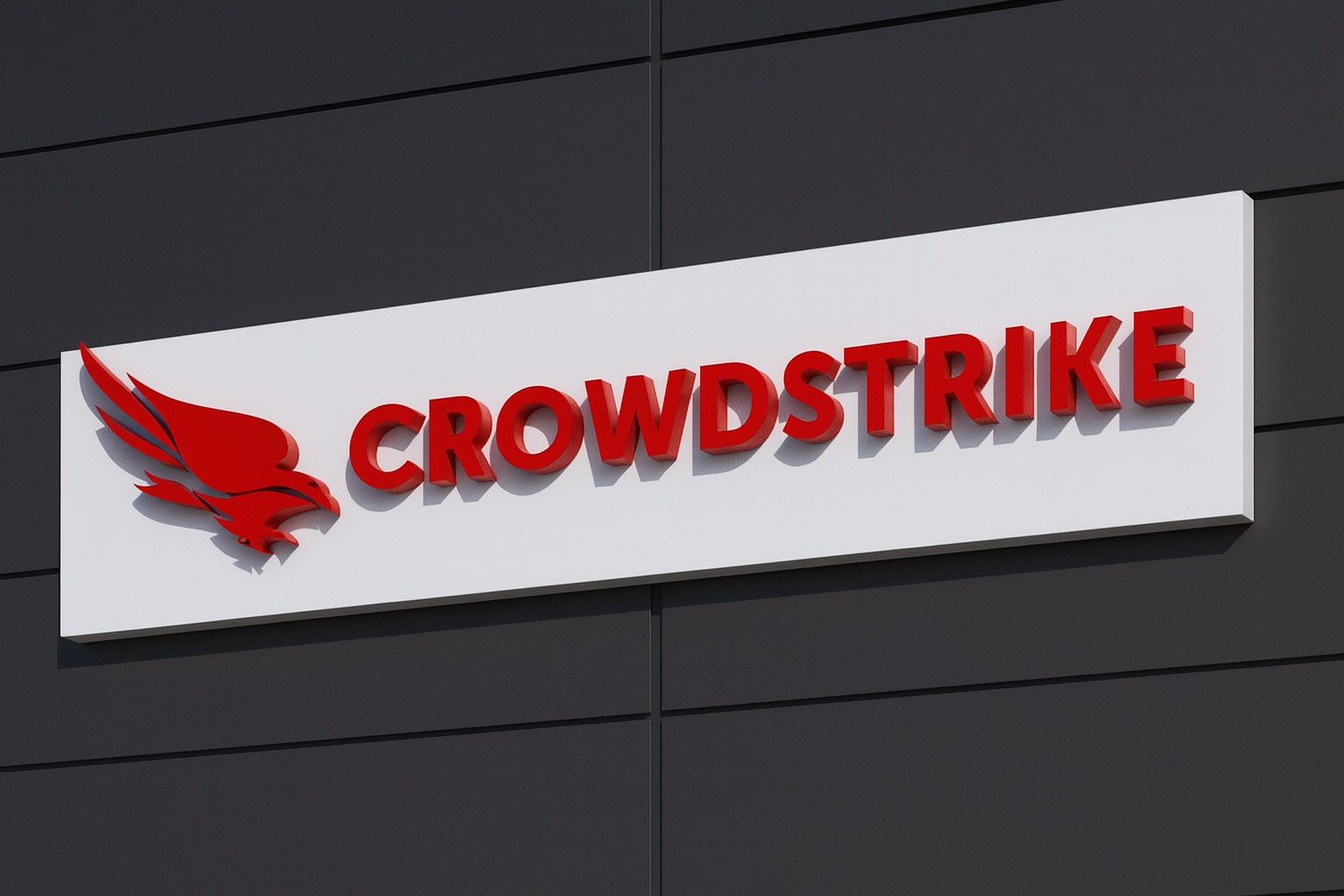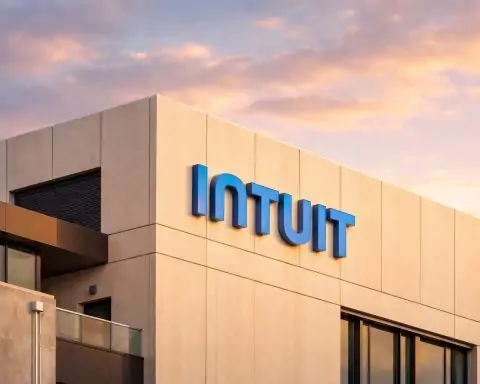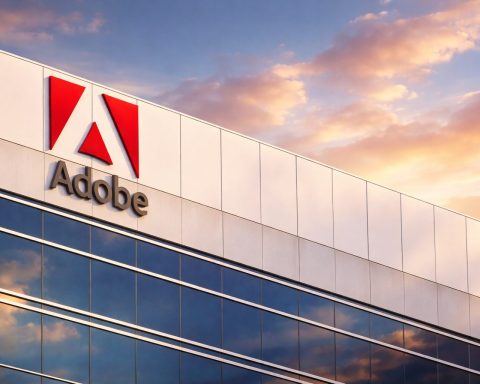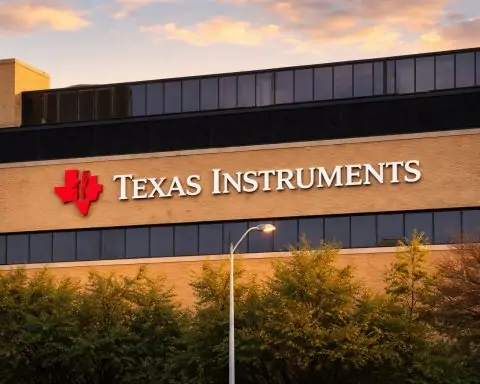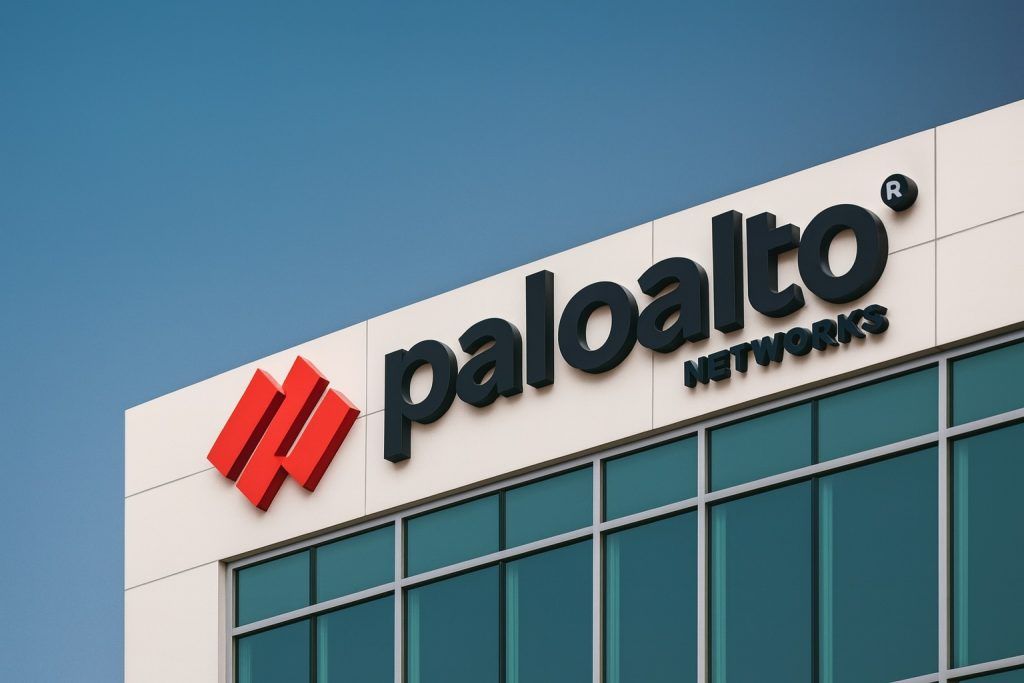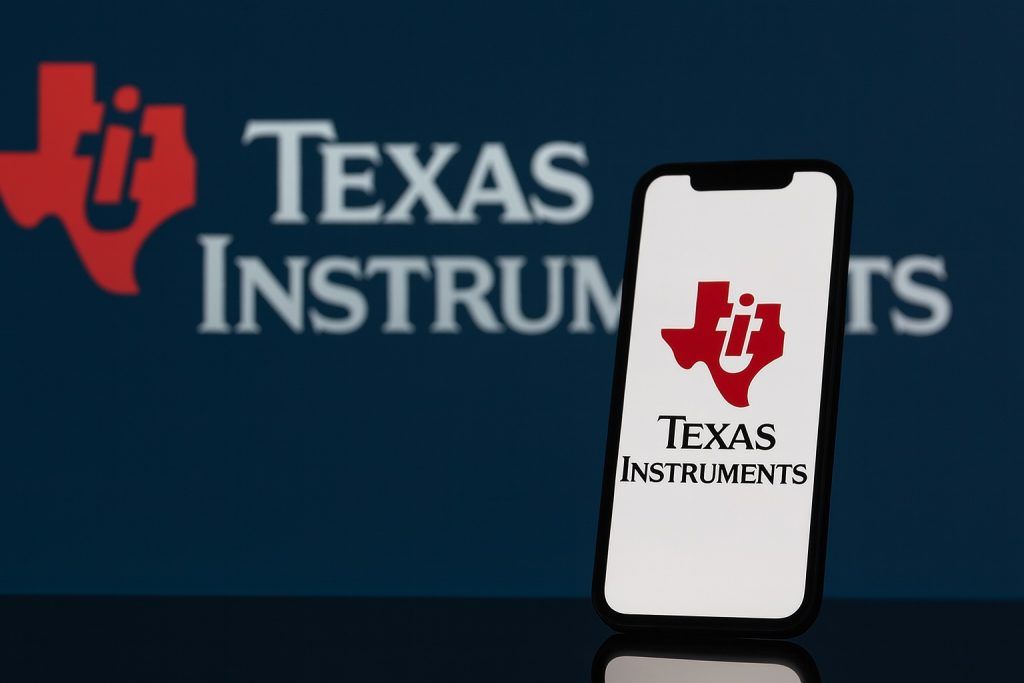What to Know Before Markets Open on October 20, 2025
- Current Price & Performance: CrowdStrike (NASDAQ: CRWD) stock is hovering around $484.65 per share after Friday’s close [1]. It notched a 0.5% daily gain on Friday and sits slightly lower for the week, consolidating near all-time highs (52-week peak was $517.98 in July [2]). The stock has surged ~56% in the past year [3], dramatically outperforming the broader market, though it remains volatile amid tech sector swings.
- Latest News & Catalysts:CrowdStrike was just named a “Visionary” in Gartner’s 2025 Magic Quadrant for SIEM [4] – a nod to its AI-driven Falcon platform – reinforcing its industry leadership. The company also expanded its partnership with Wipro to launch an AI-powered managed security service (CyberShield MDR) that leverages CrowdStrike’s Falcon SIEM for real-time threat response [5]. In insider news, a board director cashed out $1.15 million in shares on Oct. 15 (a modest 2.9% stake reduction) [6], even as institutional investors increased positions last quarter.
- Analyst Sentiment: Wall Street remains bullish on CrowdStrike’s prospects. Oppenheimer reaffirmed its Outperform rating on CRWD last week [7], and TD Cowen recently hiked its price target to $580 (Buy) citing strong execution [8]. In total, ~30 analysts rate CRWD a Buy (vs only a few Holds/Sells), yielding a “Moderate Buy” consensus [9]. The average 12-month price target is around $495 [10] – just above the current price – indicating expectations for further upside, albeit modest. Some outliers are far more bullish (targets reaching the $600 range [11]), while at least one firm (DZ Bank) issued a Sell with a $440 target, warning the stock looks stretched after its rally [12].
- Financial Highlights: CrowdStrike’s growth remains robust. Last quarter, revenue jumped 21% year-over-year to $1.17 billion with EPS of $0.93 handily beating estimates [13]. The company slightly raised its full-year outlook, guiding FY2026 earnings per share of $3.60–3.72 and accelerating its investments in AI security. Next earnings (Dec 2) will be closely watched – consensus calls for ~$1.21 billion in revenue (+20% YoY) and $0.93–0.94 EPS [14]. For the full fiscal year, analysts forecast ~$4.8 billion revenue (≈21% growth) but a small EPS dip (~–6%) as CrowdStrike plows money into expansion [15] [16]. Notably, CrowdStrike has been consistently raising guidance and carries a coveted Zacks Rank #1 Strong Buy due to upward earnings revisions [17].
- Cybersecurity Market & Outlook: Booming cyber demand and AI innovation form a strong tailwind for CrowdStrike. Cyber threats are at all-time highs – even tech giants like Microsoft and Oracle suffered major breaches in 2025 [18] – compelling enterprises to prioritize security spending. This urgency, along with an “AI arms race” in cyber (hackers weaponizing generative AI, while defenders deploy AI copilots), plays directly to CrowdStrike’s strengths [19]. The company’s cloud-native Falcon platform uses AI-driven automation and massive data (trillions of events) to spot novel threats and stop breaches in real time [20]. “This is how we stop breaches at the speed of AI,” CEO George Kurtz said, highlighting how acquisitions like Onum (a real-time data pipeline startup bought for ~$290 million) will drive “autonomous cybersecurity at scale.” [21]
Stock Performance: Near Highs After 2025 Rally
CrowdStrike’s stock has been on a tear in 2025, riding the broader AI-powered cybersecurity boom. Shares currently trade around $484–485, just 6% shy of their record high ($517.98) set in July [22]. The price is up slightly from last week’s close (after a +0.50% bump on Friday) [23], though it pulled back mid-week amid tech sector volatility. On Tuesday, CRWD briefly dipped almost 4% as part of a broader tech sell-off on concerns about peaking AI demand [24]. However, the stock rebounded quickly by Wednesday, buoyed by bullish analyst commentary and sector momentum. For instance, TD Cowen’s upgrade to a $580 target on Oct 6 helped spark renewed buying interest [25].
Overall, momentum remains firmly positive. CrowdStrike has gained approximately 65% year-over-year [26] and about 40% year-to-date, vastly outperforming the S&P 500. This strong intermediate-term performance even earned CRWD a 100% “strong interest” score on a quantitative momentum model, indicating durable trend strength based on fundamentals and price action [27]. In other words, the stock’s relative strength and growth profile have placed it among the top names in the software sector for momentum investors.
It’s worth noting that trading volumes in CRWD have been healthy – roughly 1.9 million shares exchanged hands on Friday, close to average [28] – suggesting solid investor engagement. The stock’s 1-year range spans from a low of $294.68 to the $517.98 peak [29], reflecting how far it has climbed over the past year. At a market capitalization near $122 billion, CrowdStrike is now one of the world’s most valuable cybersecurity pure-plays, on par with or even surpassing some legacy tech firms. Volatility remains moderate (beta ~1.2 [30]), but as this week showed, high-growth names like CRWD can swing sharply on shifting market sentiment.
Visionary Recognition and New AI Security Offerings
Several fresh catalysts emerged in recent days that underscore CrowdStrike’s technological momentum:
- Gartner “Visionary” Status: On October 16, CrowdStrike announced it has been recognized as a Visionary in the 2025 Gartner Magic Quadrant for Security Information and Event Management (SIEM) [31]. This placement – in Gartner’s influential grid for SIEM solutions – highlights CrowdStrike’s progress in reinventing the SIEM space with its cloud-native approach. The company’s Falcon LogScale / Next-Gen SIEM platform leverages AI-driven detections and real-time data streaming to address the shortcomings of legacy SIEMs (which often suffered from slow searches, limited data retention, and high costs) [32]. Industry analysts see this recognition as validation of CrowdStrike’s expanding influence in enterprise security modernization [33]. While such accolades don’t instantly boost sales, they reinforce CrowdStrike’s credibility and could open doors with customers looking to replace aging SIEM tools. It also underscores the breadth of CrowdStrike’s portfolio beyond endpoint protection – the company is now competing in adjacent arenas like log management and security analytics, backed by its recent acquisition of Humio (now Falcon LogScale) and innovations in AI. In short, Gartner’s nod “highlights [Falcon SIEM’s] advancements with AI-powered detections and real-time streaming technology,” signaling momentum toward cloud-native, AI-enhanced security ops [34] and bolstering CrowdStrike’s reputation as a forward-thinking leader in cybersecurity.
- Wipro Partnership for AI Security Services: CrowdStrike is extending its reach via alliances. In mid-September (with details revealed publicly on Oct 16), Wipro Limited – a global IT services provider – announced an expanded partnership with CrowdStrike to launch “Wipro CyberShield MDR,” an AI-powered unified managed security service [35]. This service, powered by CrowdStrike’s Falcon® platform and Next-Gen SIEM, aims to simplify and strengthen enterprise security by offering 24/7 managed detection and response across endpoints, cloud workloads, identities, and networks [36] [37]. Essentially, Wipro is packaging CrowdStrike’s technology (including Falcon SIEM and endpoint protection) into its own managed service, operating out of Wipro’s global Cyber Defense Centers. The offering provides clients with “enhanced visibility, AI-driven automation, and greater efficiency” in their security operations [38]. This is a notable go-to-market move: Wipro’s large enterprise customer base and global reach can significantly extend CrowdStrike’s footprint. Analysts note that this “aligns with [CrowdStrike’s] broader catalyst of expanding cloud-based offerings and partner integrations to capture market share,” accelerating customer adoption via MSSP channels [39]. From a strategic view, the partnership with Wipro (and others like it) turns CrowdStrike into a security platform backbone for service providers. By integrating with Wipro’s AI-powered CyberShield platform, CrowdStrike gains another avenue to penetrate big clients who prefer outsourced security operations, all while reinforcing the value of Falcon’s data and automation capabilities. As Wipro’s Cybersecurity SVP put it, combining Wipro’s platform with CrowdStrike’s “AI-native product suites” will enable swift threat containment and “AI automated workflows” to eliminate gaps left by siloed tools [40]. Likewise, CrowdStrike’s Chief Business Officer noted that Falcon is “supercharging” Wipro’s services to deliver real-time detection and response, giving customers confidence against today’s fast-moving threats [41].
- Fal.Con 2025 Product Unveils: At CrowdStrike’s annual Fal.Con 2025 conference (held in September), the company showcased a range of new capabilities which are now coming into play as differentiators. Notably, CrowdStrike rolled out new identity protection and AI-era data security features to combat emerging threats. These included phishing-resistant authentication methods and AI-powered data loss prevention tools, aimed at countering attackers who are increasingly using AI to generate more convincing phishing emails or to find novel ways to exfiltrate data [42]. The company is also pushing the concept of the “Agentic SOC” – essentially a security operations center enhanced with autonomous agents. At Fal.Con, CrowdStrike introduced seven new “mission-ready” AI agents designed to automate high-friction SOC tasks (from log analysis to threat hunting) so that human analysts can focus on strategic decision-making [43]. These agents tie into Falcon’s platform and take advantage of the rich telemetry and Onum’s real-time data streaming to respond in seconds to incidents. CEO George Kurtz also highlighted real-world context at the event – noting a surge in state-sponsored attacks (for example, an uptick in Iran-linked cyberattacks amid Middle East tensions) – as proof that security teams need better tools to handle the deluge of sophisticated threats [44]. The Fal.Con announcements reinforced CrowdStrike’s message that it is at the cutting edge of using AI for cyber defense, and help keep customers within the Falcon ecosystem by extending the platform’s functionality. These innovations not only help attract new customers but also upsell additional modules to existing ones (a key driver of CrowdStrike’s impressive net retention rate).
- Onum Acquisition: Underpinning many of the above developments is CrowdStrike’s recent acquisition of Onum – a real-time data observability and streaming company – for roughly $290 million (announced in late August) [45]. Onum’s technology is being integrated to turbocharge Falcon’s data handling: by enabling real-time, in-stream processing of security data, it eliminates delays and bottlenecks associated with moving data between systems. According to CrowdStrike, Onum’s approach can cut data storage costs by up to 50% and deliver incident response 70% faster thanks to in-pipeline analytics and reduced ingestion overhead [46]. In practical terms, this means Falcon can ingest and analyze massive volumes of logs and events from third-party sources without needing slow batch imports or expensive storage of everything. The context here is crucial – traditional SIEMs often choke on the “big data” problem, forcing customers to either limit what data they ingest or pay huge costs. CrowdStrike, with Onum, is positioning Falcon SIEM as a solution to that, providing hyper-scalable, cost-efficient data ingestion with AI analysis on the fly [47]. This makes CrowdStrike’s platform more attractive for customers seeking to replace legacy SIEMs or augment their SOC with faster analytics. Also, by owning a technology like Onum, CrowdStrike reduces its own reliance on external data pipeline tools and can innovate faster in how it delivers threat intelligence from cloud to endpoint. From an investor standpoint, the Onum deal shows CrowdStrike’s willingness to deploy capital for strategic tech that enhances its “unified platform” vision. It fits the pattern of prior acquisitions (like Humio for log management, Preempt for identity) that fill gaps and expand the platform’s capabilities. Over time, if Falcon’s data and AI prowess continues to improve, it widens the moat against competitors that might struggle with data scale or AI integration.
- Insider & Institutional Activity: On the corporate side, insider trading and major holdings have made some news. Director Johanna Flower sold 2,347 shares of CrowdStrike on Oct. 15 at an average ~$490.98, totaling $1.15 million [48]. This sale, executed under a 10b5-1 pre-planned scheme, represented a 2.88% reduction in her stake, leaving her with roughly 79,000 shares (worth ~$39 million) [49] [50]. Similarly, filings last quarter showed CFO Burt Podbere and Director Sameer Gandhi also sold chunks of stock (in August and September respectively) for a combined ~$8 million [51]. While insider selling can sometimes spook investors, in CrowdStrike’s case these sales were relatively small portions of their holdings and were likely profit-taking after the stock’s big run (CRWD is up ~150% from early 2023 levels). In fact, over the entire last quarter, insiders sold 158,090 shares worth $75.5 million [52] – notable, but not unusual for a company of CrowdStrike’s size and growth (insiders still retain about 3.3% of the company [53]). Meanwhile, institutional investors have been net buyers. According to Nasdaq/Fintel data, the number of institutional funds holding CRWD rose by 198 (about +7%) last quarter, and total institutional ownership increased 6.99% to 210 million shares [54]. Roughly 71% of CRWD’s stock is now owned by institutions (hedge funds, mutual funds, pension funds, etc.) [55] – a very high figure that signals strong interest from big investors. Top holders like Vanguard, BlackRock, and Morgan Stanley have all added to positions [56] [57]. This institutional support provides a degree of stability and vote of confidence in CrowdStrike’s long-term story, though it also means the stock can be affected by broader fund flows (e.g., if tech sector ETFs see inflows or outflows).
Wall Street’s Take: Growth Optimism, Valuation Caution
Analysts covering CrowdStrike broadly agree that the company’s fundamentals are stellar, while acknowledging the stock’s high valuation as a key issue. As of mid-October 2025, 31 out of 48 analysts tracked by MarketBeat have a Buy or Strong Buy rating on CRWD, 17 rate it Hold, and only 2 say Sell, yielding an overall “Moderate Buy” consensus outlook [58]. This skew toward bullish ratings reflects CrowdStrike’s execution and market position – it’s rare to see so few bears on a $100+ billion tech stock.
The average 12-month price target across analysts is approximately $490–$495, right around the current trading level [59]. This suggests that, in aggregate, analysts think the stock is fairly valued at the moment, with only modest upside. Indeed, several analysts have price targets in the $480s or $490s, essentially at-market. However, there’s a wide dispersion in targets: according to TradingView collating analyst forecasts, targets range from as low as ~$343 to as high as $600 [60]. Many top-tier firms lie in between – for instance, the FactSet consensus (which can differ slightly from MarketBeat) shows an average around $503 with an Overweight rating [61].
Some recent analyst actions illustrate the sentiment:
- Oppenheimer (Oct 17) maintained an Outperform and reportedly raised its target from $520 to $560, praising CrowdStrike’s strong large customer growth and recurring revenue base (Oppenheimer’s new target implies significant upside) [62].
- TD Cowen (Oct 6) reiterated an Outperform/Buy and hiked its target to $580 (from $500) [63], one of the highest on the street. Cowen’s bullish case centers on CrowdStrike’s opportunity to further monetize its platform with new modules and services (like log management, identity, cloud) and its view that CrowdStrike is “winning the AI cybersecurity race”.
- Barclays (Sept 18) reaffirmed Overweight, nudging its target up to $515 (from $500) [64], citing confidence in continued 20%+ growth and noting that valuation, while rich, is justified by the company’s “rule of 40” metrics (CrowdStrike’s revenue growth + free cash flow margin comfortably exceeds 40).
- Morgan Stanley (Sept 18) kept an Equal-Weight with a target of $475 [65], basically arguing the stock was fully valued around $500 at the time. MS is positive on CrowdStrike’s competitive positioning but expressed caution that much of the good news was priced in and that they’d await a better entry point or an unexpected acceleration to turn more bullish.
- Piper Sandler (Aug 28) cut its rating to Neutral and reduced its target to $450 [66]. Piper was one of the first to pump the brakes on valuation, contending that CrowdStrike’s ~30x forward sales multiple was hard to expand further and that any hiccup could send shares lower. Since that call, the stock did briefly dip in early October, but has largely held up, so Piper remains a bit of an outlier on the cautious side.
Importantly, the bull thesis from analysts is that CrowdStrike will continue delivering high growth, and over time its earnings will grow into the valuation. For example, Evercore ISI (Sept 18) raised its target to $430 [67] but emphasized that was a 12-month view, and that longer-term they see CrowdStrike as a much larger company. Many analysts highlight the company’s expanding total addressable market (TAM) – once just endpoint security, now adding cloud, identity, SIEM, etc. – as supporting years of 20% growth ahead. They also point to metrics like ARR growth (37% YoY) and net retention (well over 120%) as evidence of a strong business model.
On the flip side, the bearish or neutral arguments largely boil down to valuation and competitive risks. Detractors note that at ~135× forward earnings and ~28× forward sales [68], CRWD is priced far above the average tech stock, and even above most high-growth software peers (for instance, fast-growing cybersecurity peer SentinelOne trades at roughly 15x sales; Palo Alto Networks at ~10x sales and 50x earnings [69] [70]). This lofty valuation leaves the stock “priced for perfection,” as some put it [71]. Any slowdown towards, say, 15% growth or any sign of market saturation could compress these multiples quickly. A few analysts also worry about macro factors – if interest rates stay high or risk appetite dwindles, highly valued stocks like CRWD could see multiples contract even if the business performs well (we saw some of this dynamic in late 2024’s tech sell-off).
Another caution comes from independent equity researchers: Simply Wall St noted that by their discounted cash flow (DCF) analysis, CrowdStrike’s stock was ~15–20% overvalued relative to its intrinsic value [72], unless the company sustains high growth for many years. They estimate a fair value closer to $413 per share [73], though they also acknowledge the company’s execution could indeed outperform those baseline assumptions.
In summary, Wall Street’s view is optimistic on CrowdStrike’s business – nearly all agree it’s a top-notch franchise in a booming sector – but divided on the stock primarily because of valuation. The consensus “Moderate Buy” rating can be interpreted as “Buy the company, at the right price.” Right now, that price is around the current levels for many, but there’s also a sense that further share appreciation will require either continuing earnings surprises or a broader market shift to favor high-growth tech even more. The next earnings report and guidance updates will be pivotal in either validating the bulls (if numbers beat and raise, justifying higher targets) or fueling the skeptics (if results merely meet expectations or show any soft spots).
Financials and Growth Trajectory
CrowdStrike’s financial performance provides a concrete foundation for its valuation – the company is delivering growth at scale that few enterprise software firms achieve.
In the most recent quarter (FY2026 Q2, reported August 30, 2025), CrowdStrike’s revenue grew 21.4% to $1.17 billion [74], slightly above the consensus $1.15B. This marked the 17th straight quarter of 50%+ YoY growth if we measure in constant currency and adjust for acquisitions – an extraordinary streak, though that growth rate has naturally decelerated from triple digits a couple years ago to around 20–30% now as the base gets larger. Importantly, revenue growth was driven not just by new customers but also by existing customers purchasing more modules. The company’s dollar-based retention rate remains above 120%, meaning the average customer spends >20% more each year. CrowdStrike ended the quarter with Annual Recurring Revenue (ARR) of $2.93 billion, up 37% YoY, indicating future revenue in the pipeline is strong.
On the profitability side, CrowdStrike is one of the rare high-growth SaaS companies that turned profitable relatively early (on an adjusted basis). Last quarter’s Non-GAAP EPS was $0.93, handily beating analyst estimates of $0.83 [75]. This was up from $0.36 two years prior and shows the operating leverage in the model: gross margins have held in the high-70% range, and while operating expenses continue to grow (especially R&D and sales), they are growing more slowly than revenue. The company’s free cash flow (FCF) is even more impressive – it generated $188 million in FCF last quarter (about 32% of revenue), thanks to efficient operations and upfront annual billings. CrowdStrike’s FCF margin puts it in elite company; indeed, it meets the so-called “Rule of 40” easily (in the latest quarter, revenue growth + FCF margin ~ 53). This balances growth with profitability and is a sign of a healthy SaaS business.
However, on a GAAP basis, CrowdStrike still posted a net loss of about $77.5 million last quarter [76], largely due to heavy stock-based compensation (SBC) expenses, which are excluded in non-GAAP metrics. The GAAP net margin was -6.8% [77]. This is why you see a GAAP P/E ratio that is negative (or nonsensical) – GAAP earnings are negative, so the P/E is not meaningful [78]. The key is whether SBC is diluting shareholders excessively. CrowdStrike’s SBC was roughly $180M last quarter, which is high (~15% of revenue), but its share count only crept up ~1% YoY, meaning they manage dilution via share buybacks or offsetting growth. This is something to watch, but so far investors seem comfortable given the growth being delivered.
Looking ahead, CrowdStrike’s guidance and forecasts indicate confidence in sustained momentum:
- For the current quarter (FY2026 Q3, ending Oct 31), the company guided to $1.15–1.17 billion in revenue and $0.93–0.95 adjusted EPS [79]. At the midpoint, that’s ~19% revenue growth YoY and essentially flat EPS sequentially (since Q2 was $0.93). This guidance was likely conservative – CrowdStrike has a pattern of guiding low and then beating. Analysts are generally forecasting the high end of guidance (~$1.17B and $0.95 EPS). Notably, the company’s Q3 will lap an unusually strong quarter from the prior year (when many deals closed early), so the YoY compare is a bit tougher; this partly explains the <20% growth outlook, which should reaccelerate in Q4 if deal timing normalizes.
- For the full fiscal year (ending Jan 2026), CrowdStrike raised its outlook in August. It now expects revenue of ~$4.67 billion at the midpoint (up ~20% YoY) and Non-GAAP EPS of ~$3.66 [80]. This was an uptick from prior guidance and shows that despite macro headwinds (like some longer sales cycles in Europe), CrowdStrike is still adding business at a fast clip. The FY2026 EPS guidance actually implies a slight decline vs FY2025’s $3.82 non-GAAP EPS – this is deliberate, as the company is reinvesting heavily in growth initiatives. R&D spending in particular is ramping (expected up ~50% this year) to fund AI development, new product engineering, and cloud infrastructure for data/AI services. The market seems to approve of this strategy, as long as revenue keeps growing ~20%+. The slight EPS dip (~6% down) was well-telegraphed and considered a short-term trade-off [81] [82].
- Looking further out, analyst consensus for FY2027 (calendar 2026) sees revenue reaching ~$5.6 billion (+19% YoY) and Non-GAAP EPS rebounding to ~$4.50–4.70 (which would be ~25% growth in EPS). This assumes operating leverage returns as the big investments of this year start paying off, and as some expenses (like cloud hosting) grow more slowly due to efficiency gains (possibly from Onum’s tech). By FY2027, some models even project CrowdStrike’s GAAP profitability to flip positive, though that depends on SBC trends.
One notable financial achievement: CrowdStrike’s annual revenue run-rate (ARR) now exceeds $4 billion, putting it in a very select club of cybersecurity companies at that scale (Palo Alto is one of the few larger, with ~$10B ARR). And yet, CrowdStrike’s growth rate is double or more that of most larger peers. This has prompted some analysts to compare CrowdStrike’s trajectory to that of Salesforce or ServiceNow in their earlier days, as a company that dominates its niche and then expands TAM to keep growth high even at scale [83].
From a balance sheet perspective, CrowdStrike is in a comfortable spot. It has about $3.3 billion in cash and investments (as of July 31, 2025) and manageable debt (approximately $740M in convertible notes, which many expect will convert to equity if the stock stays high, plus some lease obligations). The debt-to-equity ratio is just 0.20 [84], and with positive free cash flow, the company isn’t reliant on external funding. This means CrowdStrike can continue strategic M&A (like Onum) or potentially initiate shareholder returns (no indication of that yet, as growth is the focus) without balance sheet concerns.
In summary, CrowdStrike’s financials paint the picture of a company balancing high growth with improving profitability. It has reached a scale where it can invest in multiple growth initiatives (AI, new products, international expansion) while still delivering strong margins in its core business. The main risk is whether growth can stay in the ~20%+ zone for multiple years to come – if it does, the earnings will eventually justify the valuation (as the “rule of 40” and beyond compounds). If growth were to unexpectedly drop into the low-teens in a couple of years, then the valuation could appear untenable. So far, there’s no sign of that; pipeline and ARR trends are robust, and CrowdStrike continues to land large contracts (the number of $1M+ ARR customers grew 52% YoY last quarter).
Competitive Landscape and Industry Trends
CrowdStrike operates in one of the most dynamic sectors of tech – cybersecurity – where the competitive landscape is intense but the market pie is rapidly growing. Understanding its position requires looking at both direct competitors and broader industry trends:
Key Competitors:
- SentinelOne (S) – Often dubbed CrowdStrike’s closest rival in endpoint security, SentinelOne offers AI-driven endpoint protection similar to Falcon. It’s much smaller in revenue (~$820M expected this year) but growing slightly faster (mid-20s% range) [85]. SentinelOne competes aggressively on technology claims (often boasting about AI efficacy) and price, especially in mid-market deals. However, SentinelOne only recently reached cash-flow breakeven and remains unprofitable on GAAP, whereas CrowdStrike is profitable (non-GAAP) and far larger [86]. This means CrowdStrike can outspend SentinelOne in R&D and sales if needed. The rivalry has pushed both companies to innovate rapidly – e.g., SentinelOne acquired Attivo Networks (identity threat detection) to expand its platform following CrowdStrike’s moves, and both are building XDR capabilities. Industry experts note that their competition has “pushed the entire industry towards more automation and smarter analytics”, benefiting customers who now get more advanced solutions [87]. SentinelOne’s lower price point has won it some cost-conscious customers, but many large enterprises still choose CrowdStrike for its more mature platform and broader offerings. The bottom line: SentinelOne is a credible challenger, but at this point CrowdStrike’s lead in data, ecosystem and financial stability gives it an edge in most head-to-head contests.
- Palo Alto Networks (PANW) – While not a direct 1:1 competitor in endpoint, Palo Alto has emerged as a formidable competitor through adjacent markets and its platform approach. Palo Alto is the largest pure-play cybersecurity firm by revenue (projecting ~$10.5B in FY2026) [88] [89] and has a vast customer base in firewalls, cloud security (Prisma Cloud), and security operations (its Cortex XDR competes in detection/response). It has been converging into CrowdStrike’s turf: notably, in mid-2025 Palo Alto announced a $25 billion acquisition of CyberArk (an identity security leader) [90], signaling intent to cover identity protection – an area CrowdStrike also moved into via its Preempt acquisition. This means Palo Alto will soon offer endpoint-like identity threat detection, potentially bundled with its other products. Palo Alto’s strategy is a platform consolidation play – as one exec put it, to be the “Amazon of cybersecurity,” offering everything under one roof [91]. This trend of consolidation is significant: many CISOs prefer to buy integrated solutions from fewer vendors for simplicity and better integration [92]. CrowdStrike is responding by building its own broad platform (endpoint, cloud, identity, SIEM, etc.) and partnering where needed (e.g., Zscaler for network). Palo Alto’s advantages are its huge sales force and customer relationships; it can bundle products (including maybe undercutting on price by packaging multiple capabilities). It also has a strong presence in sectors like government where CrowdStrike is still expanding. However, Palo Alto’s challenge is integrating these acquisitions and convincing customers that one vendor can be best-of-breed in all areas. For now, CrowdStrike and Palo Alto often complement each other (some companies use both – PANW for network, CRWD for endpoint), but their offerings are on a collision course. Investors sometimes compare the two: Palo Alto’s growth (~15%) is slower but it’s more profitable (operating margins ~30%, FCF ~40% [93] [94]) and cheaper in valuation, whereas CrowdStrike is the high-growth pure-play. Both can thrive in a growing market, but if budgets tighten, expect the competition for share to heat up, perhaps affecting pricing.
- Microsoft (MSFT) Defender – One cannot overlook Microsoft as a competitor, given its pervasive presence on endpoints (Windows) and in the cloud (Azure). Microsoft Defender, which is part of Microsoft’s 365 and Windows security suite, offers antivirus and basic EDR (endpoint detection & response) capabilities that for some organizations are “good enough.” Microsoft has been steadily improving Defender, and it bundles it essentially for free with many enterprise licenses. This poses a challenge: CrowdStrike has to prove a clear superior value to convince companies to pay extra rather than stick with the built-in security. So far, CrowdStrike has done well – many enterprises report that Falcon catches things Defender misses and that CrowdStrike’s managed hunting and support are far superior. Moreover, CrowdStrike works cross-platform (Windows, macOS, Linux, cloud workloads, containers, etc.), whereas Microsoft’s solutions are strongest in Windows-centric environments. CrowdStrike’s independent status also means it can integrate widely (with AWS, with Google, with various IT tools) – an appeal to customers who have heterogenous environments. However, Microsoft is a deep-pocketed rival that is investing heavily in security (they announced a $20B investment plan in cyber over 5 years in 2021). They are embedding AI into Defender and Sentinel (their cloud SIEM/SOAR) using their OpenAI partnership. Microsoft also often comes up in deals as the “incumbent by default” that CrowdStrike has to displace. Many companies do an RFP where the final choice is between sticking with/upgrading Defender or going to CrowdStrike. Thus far, CrowdStrike’s win rate against Defender is high, but the gap could narrow if Microsoft closes the feature gap. CrowdStrike’s strategy is to stay two steps ahead technologically (especially in AI threat detection) and to highlight that security is not Microsoft’s core focus – whereas it is CrowdStrike’s sole focus. Additionally, some enterprises prefer an independent security vendor due to concerns about putting all eggs in one basket with Microsoft. In summary, Microsoft is a competitive factor mostly at the lower end (small businesses, or cost-driven scenarios), but less so in high-security environments where best-of-breed is required.
- Other Notable Players: The cyber market is fragmented with many specialized firms:
- Traditional Antivirus companies like Trend Micro, McAfee, Symantec (Broadcom) – These were leaders in the pre-2015 endpoint market. Many have since shifted focus (Broadcom/Symantec now does more network and info security for existing customers), and they often lack the cloud-native architecture and AI focus of CrowdStrike. CrowdStrike has been steadily taking share from these incumbents in the endpoint market.
- Next-Gen startups – Beyond SentinelOne, dozens of startups target pieces of the pie: e.g., CrowdStrike vs. Okta in identity protection (CrowdStrike’s new Falcon Identity Threat Protection vs Okta’s Auth0 and behavior detection); vs. Splunk in log management/SIEM (Falcon LogScale vs Splunk Cloud); vs. Zscaler or Netskope in certain cloud security aspects (though here CrowdStrike chose partnership with Zscaler rather than competition). Most smaller startups either partner with CrowdStrike (e.g., through the CrowdStrike Store which allows third-party apps on Falcon data) or they compete in niches but with far less reach.
- Emerging “XDR” platforms – Everyone in security is now pitching XDR (Extended Detection and Response) which basically means integrating data from multiple security tools for unified detection. CrowdStrike’s XDR approach leverages its huge endpoint presence and Threat Graph database, adding feeds from partners. Other XDR approaches might be led by SIEM vendors or by network security vendors. This is more of a feature war than a separate competitor, but how well CrowdStrike’s XDR performs vs, say, Palo Alto’s Cortex XDR or IBM’s QRadar XDR can influence buying decisions for companies looking for an integrated detection platform.
- Services vs. Products – Some competition comes from the services side. Big consulting firms (Accenture, Deloitte) and telecoms offer managed security services which sometimes include their own preferred tech stack. However, many of those MSSPs actually use CrowdStrike under the hood (because clients ask for it, or because of its efficacy). The Wipro partnership is an example of CrowdStrike embracing this channel. Still, one could argue that if companies go fully managed, they might not care which tech is used, which commoditizes the underlying product. CrowdStrike counters this by offering Falcon Complete (its own managed service on top of Falcon) to compete in the “outcomes not tools” market.
Industry Trends Benefiting CrowdStrike:
- Soaring Threat Levels: Cyberattacks are not only more frequent but more advanced. 2025 saw waves of high-profile breaches – from ransomware hitting hospitals and pipelines to espionage hacks on government and tech firms [95]. Notably, even companies like Microsoft and Oracle fell victim to serious cyber incidents in 2025 [96]. This constant drumbeat of breaches keeps cybersecurity in the spotlight (almost a daily news topic) and puts pressure on organizations to strengthen their defenses. For CrowdStrike, which emphasizes its ability to stop even novel “never-seen-before” threats (through AI and cloud analytics), these headlines effectively serve as free marketing for advanced solutions. There’s a growing recognition that legacy signature-based or perimeter-focused security is inadequate, which drives companies toward modern, AI-enabled approaches – exactly CrowdStrike’s sweet spot.
- AI Arms Race (Attackers vs. Defenders): Both cyber criminals and security teams are leveraging Artificial Intelligence in a cat-and-mouse dynamic. Attackers are using generative AI to craft incredibly convincing phishing emails at scale, automate the discovery of vulnerabilities, or even develop polymorphic malware that changes to evade detection [97]. On the flip side, defenders (like CrowdStrike) are deploying AI/ML models to identify malicious behavior patterns in real time, even if the specific threat is new. Analysts predict that by 2028, the majority of security operations will involve multiple AI agents assisting humans [98]. CrowdStrike has been at the forefront of this trend – it processes trillions of events per week in its Threat Graph and uses that data to train AI models that can, for example, detect a ransomware attack in one customer environment and immediately immunize all other customers against that threat (by recognizing similar behaviors) [99]. This network effect (“one client gets attacked, all clients benefit from the learnings”) is a huge advantage of a cloud-native platform like Falcon. As AI becomes more embedded in security, companies with big data and proven AI algorithms stand to benefit disproportionately. CrowdStrike’s early investment in AI (since its founding, essentially) gives it a strong position – its models have been learning from real-world attacks for years. This creates a high barrier to entry for any new competitor who lacks such data scale.
- Platform Consolidation: We’ve touched on this, but it’s a major trend – enterprises are tired of managing dozens of point security products and are consolidating towards platforms that can do more. A few years ago, a typical company might have separate vendors for AV, EDR, cloud workload security, ID management, SIEM, threat intel, etc. Now, many want an integrated platform or at least fewer consoles. CrowdStrike is a poster child of this consolidation from the vendor side – it started in endpoint and has expanded outward via development and acquisitions to cover a broad swath of security needs. For customers, consolidating on CrowdStrike’s Falcon platform can simplify operations and potentially reduce costs (one agent instead of many, one data backend, unified dashboards). This trend helps CrowdStrike increase its “share of wallet” per customer. It’s reflected in metrics like the average number of modules adopted: over half of CrowdStrike customers now use 5 or more Falcon modules (out of 20+ available), a number that has been steadily rising. If platform preference continues, leaders like CrowdStrike could grab outsized share, while niche point-solution vendors may struggle unless they have a truly unique capability.
- Cybersecurity Resilience in IT Budgets: Even when companies cut back on IT spending in general, cybersecurity tends to be more protected (nobody wants to be the next victim due to underinvestment). For instance, during the COVID-impacted year and in the face of economic uncertainties in 2023–2024, global cyber spending still grew by double digits annually [100] [101]. The rationale is clear: the cost of a breach (in fines, downtime, brand damage) far exceeds the cost of robust security. CrowdStrike has benefited from this resilience – its growth barely blipped during recent economic swings (still ~20%+). This doesn’t make it immune to macroeconomic forces, but it does imply a level of stability. Enterprises might delay some projects, but they are less likely to cut a best-in-class security vendor that’s protecting their crown jewels. This trend gives investors some confidence that CrowdStrike’s growth is on solid footing even if other software segments see headwinds.
Risks and Challenges in Context:
While trends are favorable, it’s worth reiterating challenges:
- High Valuation Risk: We’ve covered this extensively, but to put in context: CrowdStrike’s P/E (>100) and P/S (~25–30) multiples mean expectations of strong growth and margin expansion are baked in [102]. If CrowdStrike stumbles – say growth slips to mid-teens or a new competitive threat emerges – the stock could correct sharply. The Oct 7, 2025 pullback of ~4% after a general AI demand concern report [103] exemplifies the sensitivity. Stocks like CRWD often trade as much on sentiment (momentum) as on fundamentals in the short term. If investor sentiment toward tech or growth shifts, CrowdStrike could be swept along.
- Competition for Talent and Innovation: CrowdStrike needs to keep innovating to maintain its edge. The cybersecurity industry has a talent war – skilled threat researchers, data scientists, and engineers are in hot demand. CrowdStrike’s success can attract talent, but also competitors try to poach or replicate. If, hypothetically, a breakthrough in threat detection or a shift like quantum computing or new AI paradigms comes, CrowdStrike would need to adapt quickly. Execution risk on product development is an ever-present challenge.
- Global/Regulatory Factors: CrowdStrike is expanding internationally (EMEA and APAC are growth areas). Different countries have different data sovereignty laws, which could complicate CrowdStrike’s cloud approach (they often set up local cloud regions to handle this). Also, geopolitical issues like U.S.-China tensions mean CrowdStrike (a US-based company) might be limited in selling to certain markets (and conversely, it benefits from some govt. stances to avoid Chinese software). Additionally, increasingly some nations require use of local security software for government or critical sectors (for instance, Russia or China favor homegrown solutions for national security reasons), which could cap some TAM.
- The Ultimate “Bear Case” Scenario: Perhaps the gravest hypothetical risk is if CrowdStrike fails to prevent a major breach for a high-profile customer (or itself gets breached). Trust is crucial in cybersecurity. If an incident occurred where it was shown that CrowdStrike’s software was bypassed in a significant way, it could dent its reputation (similar to how a big breach hurt SolarWinds or how an exploit in FireEye’s tools raised concerns some years back). CrowdStrike has thus far maintained a strong track record – for example, it proudly notes that none of its customers using Falcon were breached in certain widespread attacks – but no security is 100%. The company even runs red team vs. blue team simulations internally to test its own defenses. While this risk is low probability, the impact would be high if it happened, likely leading some customers to reevaluate and providing ammunition to competitors.
All things considered, the broader cybersecurity market outlook remains very positive for vendors like CrowdStrike. IDC projects global cyber spending growth in the teens annually, reaching $300B+ within a few years [104]. With cyber threats also escalating, it’s a bit of an arms race where top vendors are likely to continue growing. CrowdStrike’s multi-faceted strategy – expanding product breadth, pushing AI/automation, partnering smartly, and maintaining financial discipline – positions it well among peers. But investors and analysts will continue to weigh those growth prospects against the valuation and competitive landscape on an ongoing basis.
Final Thoughts: Balancing High Growth and High Expectations
As of October 19, 2025, CrowdStrike stands as a bellwether of the cybersecurity industry’s future – a company delivering double-digit growth at scale, pioneering AI in cyber defense, and rapidly broadening its platform. The stock’s strong performance this year (hovering near record highs around $485) reflects the market’s belief in CrowdStrike’s execution and long-term opportunity. At the same time, a valuation north of 100× earnings means the market is effectively pre-paying for a lot of that future success. This puts CrowdStrike in a position where it must continue executing flawlessly to sustain its stock momentum.
The near-term focus will be on CrowdStrike’s upcoming earnings (Dec 2, 2025) and any guidance updates. Investors will look for confirmation that demand remains robust – e.g., ARR growth staying high, customer additions pacing well, and module adoption increasing. Any beat-and-raise (as CrowdStrike has often delivered) could propel the stock higher, potentially breaking to new all-time highs if the broader market is supportive. Conversely, if results merely meet expectations or if the macro environment (like enterprise IT spending) shows signs of sluggishness, the stock could see a pullback given its premium price.
Beyond earnings, CrowdStrike’s strategic direction appears sound. The company is wisely addressing the needs of modern enterprises by offering an integrated, AI-powered platform. It is entering adjacencies like identity and SIEM at a time when customers are seeking consolidation and more intelligent security solutions. Its willingness to partner (as seen with Wipro, Zscaler) shows a maturity in focusing on customer outcomes rather than insisting on doing everything alone. And its aggressive investment in AI and automation indicates it’s not resting on its laurels as an early mover, but rather doubling down to maintain technological leadership.
For investors, the CrowdStrike story is one of high growth balanced against high expectations. The secular trends – from relentless cyberattacks to the AI revolution in security – play to CrowdStrike’s benefit and give it a long runway. The main question is not if CrowdStrike will grow, but how profitably and how fast, and whether that growth can outpace what’s already priced in. Right now, most analysts and experts seem to think CrowdStrike will clear that bar, hence the predominance of Buy ratings. They often cite the company’s track record: since its 2019 IPO, CrowdStrike has consistently beaten estimates and expanded its platform beyond what skeptics thought possible (few imagined back then it would challenge Splunk or Okta, for instance).
However, prudent voices also remind us that in stock investing, even a great company can be a bad investment if bought at too high a price. The next 6-12 months will be crucial in demonstrating that CrowdStrike’s recent investments (Onum, new AI agents, etc.) are translating into tangible competitive advantages and financial results (like accelerating revenue or expanding margin per customer). If so, the current valuation might in hindsight look justified or even cheap (if CrowdStrike eventually becomes, say, a $10B revenue company in a few years). If not, there could be turbulence.
In the big picture, the cybersecurity market’s importance is only growing, and CrowdStrike has firmly established itself as a top platform in this arena. The company’s mantra of using cloud-scale data and AI to “stop breaches” resonates strongly with customers facing 21st-century threats. As long as CrowdStrike keeps making good on that promise – stopping breaches for clients – its business should thrive. And if the business thrives, the stock is likely to follow suit, albeit with the usual volatility along the way.
For now, CrowdStrike remains a market leader riding powerful tailwinds. It offers a compelling mix of growth and tech innovation, which is why it’s a cornerstone holding for many tech-focused portfolios. Investors will continue to watch each development – from earnings numbers to new partnerships – to gauge whether CrowdStrike can keep its edge in the fast-moving cybersecurity battle. So far, all signs point to a company that is not only keeping up, but often leading the charge in the fight against cyber adversaries, which bodes well for its long-term story.
Sources: CrowdStrike investor releases and ts2.tech analysis of CrowdStrike’s 2025 performance [105] [106]; Gartner Magic Quadrant report highlights via Business Wire/Yahoo Finance [107]; MarketBeat and Nasdaq/Fintel analyst data [108] [109]; Simply Wall St commentary on valuation and partnerships [110] [111]; TradingView market statistics and forecasts [112] [113]; Reuters and CNBC reports on cybersecurity trends and competitor moves; and expert insights from industry analysts and company executives as of Oct. 19, 2025. [114] [115]
References
1. www.marketbeat.com, 2. www.marketbeat.com, 3. www.tradingview.com, 4. investingnews.com, 5. simplywall.st, 6. www.marketbeat.com, 7. www.nasdaq.com, 8. www.marketbeat.com, 9. www.marketbeat.com, 10. www.marketbeat.com, 11. www.tradingview.com, 12. ts2.tech, 13. www.marketbeat.com, 14. ts2.tech, 15. ts2.tech, 16. ts2.tech, 17. ts2.tech, 18. ts2.tech, 19. ts2.tech, 20. ts2.tech, 21. ts2.tech, 22. www.marketbeat.com, 23. www.marketbeat.com, 24. ts2.tech, 25. ts2.tech, 26. ts2.tech, 27. ts2.tech, 28. www.marketbeat.com, 29. www.marketbeat.com, 30. www.marketbeat.com, 31. investingnews.com, 32. investingnews.com, 33. simplywall.st, 34. simplywall.st, 35. www.wipro.com, 36. www.wipro.com, 37. www.wipro.com, 38. www.wipro.com, 39. simplywall.st, 40. www.wipro.com, 41. www.wipro.com, 42. ts2.tech, 43. investingnews.com, 44. ts2.tech, 45. ts2.tech, 46. investingnews.com, 47. investingnews.com, 48. www.marketbeat.com, 49. www.marketbeat.com, 50. www.marketbeat.com, 51. www.marketbeat.com, 52. www.marketbeat.com, 53. www.marketbeat.com, 54. www.nasdaq.com, 55. www.marketbeat.com, 56. www.nasdaq.com, 57. www.nasdaq.com, 58. www.marketbeat.com, 59. www.marketbeat.com, 60. www.tradingview.com, 61. www.marketscreener.com, 62. www.marketscreener.com, 63. www.marketbeat.com, 64. www.marketbeat.com, 65. www.marketbeat.com, 66. www.marketbeat.com, 67. www.marketbeat.com, 68. ts2.tech, 69. ts2.tech, 70. ts2.tech, 71. ts2.tech, 72. ts2.tech, 73. ts2.tech, 74. www.marketbeat.com, 75. www.marketbeat.com, 76. www.tradingview.com, 77. www.marketbeat.com, 78. www.marketbeat.com, 79. www.marketbeat.com, 80. www.marketbeat.com, 81. ts2.tech, 82. ts2.tech, 83. ts2.tech, 84. www.marketbeat.com, 85. ts2.tech, 86. ts2.tech, 87. ts2.tech, 88. ts2.tech, 89. ts2.tech, 90. ts2.tech, 91. ts2.tech, 92. ts2.tech, 93. ts2.tech, 94. ts2.tech, 95. ts2.tech, 96. ts2.tech, 97. ts2.tech, 98. ts2.tech, 99. ts2.tech, 100. ts2.tech, 101. ts2.tech, 102. ts2.tech, 103. ts2.tech, 104. ts2.tech, 105. ts2.tech, 106. ts2.tech, 107. investingnews.com, 108. www.marketbeat.com, 109. www.nasdaq.com, 110. simplywall.st, 111. simplywall.st, 112. www.tradingview.com, 113. www.tradingview.com, 114. investingnews.com, 115. ts2.tech
